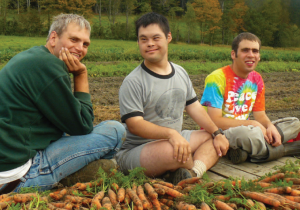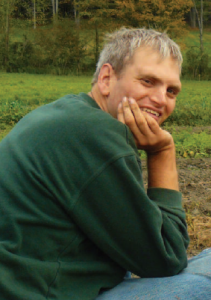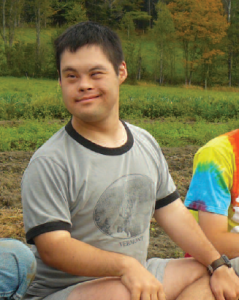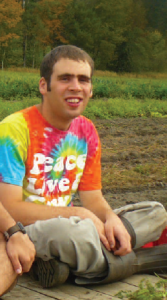Waldorf News
Peer Communities Prepare Students with Special Needs for Life and Employment after Graduation

By SHELLEY BURT
Picture yourself as a young adult finishing high school, preparing to take your next steps in the world. What opportunities await you? Which college or vocational program will you consider in order to continue learning and developing the skills necessary for a responsible adult life? High school graduation also marks a special milestone in the lives of young people with special needs, yet it can be a challenge for these individuals to find community programs that offer a college-like experience and meet the needs of developmentally disabled “emerging adults.”
By age 21, the range of support for individuals with developmental disabilities found in the public school system comes to an end. At a time when their peers are embarking on an exciting yet challenging college experience, there can be very little for young adults with special needs to look forward to. Most of these individuals will not be prepared to live independently and will find themselves at home with Mom and Dad, relying on their parents to create a circle of friends to keep them stimulated and locate meaningful activities to occupy their days. And while group homes allow young adults to live apart from their family as college does, these residential situations rarely offer true peer to peer learning. Options for continuing education, vocational exploration and genuine social relations are often less plentiful than parents might hope.
Fortunately, there are three Youth Guidance communities that are part of Camphill in North America (www.camphill.org) that recognize the gap in educational opportunities and choice of work Camphill recognizes the gap in educational opportunities and choice of work for young adults with special needs. Camphill’s residential programs at Camphill Soltane, Camphill Community Triform and the Transition Program at Beaver Farm (a part of Camphill Special School in Pennsylvania) offer supportive college-like experiences consciously tailored to the needs and special life tasks of the emerging young adult, including those diagnosed with Down syndrome, autism, Fragile X and cerebral palsy.
 These lifesharing communities, where individuals with special needs (“residents”) live together with residential volunteers (“coworkers”), follow a model of care which distinguishes all 100 Camphill communities worldwide. The model first emerged in Scotland over 70 years ago and came to the United States in the 1960s. In North America, Camphill communities can be found in New York, Pennsylvania, California, Minnesota, Vermont and Missouri as well as in British Columbia and Ontario.
These lifesharing communities, where individuals with special needs (“residents”) live together with residential volunteers (“coworkers”), follow a model of care which distinguishes all 100 Camphill communities worldwide. The model first emerged in Scotland over 70 years ago and came to the United States in the 1960s. In North America, Camphill communities can be found in New York, Pennsylvania, California, Minnesota, Vermont and Missouri as well as in British Columbia and Ontario.
“The question for every adolescent, with or without intellectual disabilities, is how to go from depending on a teacher for guidance to being self-guided,” explains Guy Alma, Director of the Transition Program at Beaver Farm in Glenmoore, Pennsylvania. When individuals with special needs move directly from the public education system into the support offered by adult social services, this interim step is often missing. “Youth Guidance gives young adults the supportive structure they need to start making healthy choices for themselves in whatever area of life they are ready to explore,” says Alma. “Whether it’s trying out different sorts of career avenues, learning how to be mentored in a job placement or simply mastering the skill of self-dressing.”
Tim Paholak, President of Triform Camphill Community in Hudson, New York, believes Youth Guidance makes sense because it addresses a critical stage of the human life cycle. “There’s a real window of opportunity between ages 18 to 30 to help young people make important steps they couldn’t consider doing when they were younger. It’s a time when people can take big strides in relation to themselves, the world and to nature. They can emerge from this process as real citizens of the planet.”
Three Key Elements for Success
The team of coworkers and residents that shape the day-to-day activities at Camphill Youth Guidance communities point to three key elements of their success. First is the opportunity to live, learn and grow with other young adults. For some students the experience at Camphill is the first fully supportive peer group they have ever known. As Nick Gianoulis, father of a student at Camphill Soltane admits, “My idea of fun and entertainment wasn’t always aligned with what my daughter, Alyssa, would have chosen. What serves Alyssa best is being amongst her peers. Alyssa has really come out of her shell and has become interested in activities that I never would have expected.”
 Second is the singular focus on the life needs of the young adult, the clear expectation that life at Camphill will prepare them for a fuller, more engaged and self-aware grown-up life. Beth Eagen found that Camphill provided this sort of preparation for her 23-year-old son, Michael. “The general proficiencies he has acquired in daily learning sessions and activities can be transferred to any home, community, training, volunteer setting, or paid work activity. Through numerous opportunities to practice his skills at making choices, he is building a path for himself in life. He is planning and participating in future goal-making to the best of his ability in a manner that provides him with a deep sense of freedom and satisfaction.”
Second is the singular focus on the life needs of the young adult, the clear expectation that life at Camphill will prepare them for a fuller, more engaged and self-aware grown-up life. Beth Eagen found that Camphill provided this sort of preparation for her 23-year-old son, Michael. “The general proficiencies he has acquired in daily learning sessions and activities can be transferred to any home, community, training, volunteer setting, or paid work activity. Through numerous opportunities to practice his skills at making choices, he is building a path for himself in life. He is planning and participating in future goal-making to the best of his ability in a manner that provides him with a deep sense of freedom and satisfaction.”
The final element that sets these Youth Guidance communities apart is the absence of salaried shift workers. Like all Camphill communities, the three Youth Guidance communities in North America rely on long-term residential volunteers (called “coworkers”) who have made a conscious commitment to share their life with individuals in need of special care. Supporting coworkers are not paid for their services, but are provided with their basic essentials so they can live and work at Camphill communities full time. In lifesharing communities like Camphill, everyone is expected to play a role, from the most challenged member of the group to the most capable supporting coworker. The natural learning process of real life refines social skills and competencies and students experience the chance to grow not as a “client” of a social service “provider,” but as an equal member of a lively, supportive household. As one parent remarks, “The relationship is not a hierarchical one, like that of a teacher to a student, but more of a collaboration and integration of living and learning.”
Camphill also welcome young volunteers, including AmeriCorps participants, who spend one, two or more years living and working in the communities, side by side with the supporting coworkers and residents. AmeriCorps members provide an added level of capacity that allows for more robust programming activities for individuals with developmental disabilities. In many communities, participation in Special Olympics and other social and advocacy groups are coordinated by the AmeriCorps members.
A Closer look at Community
Founded in 1979, Triform is the oldest Youth Guidance community in North America and currently serves almost 40 residential and daytime residents with a range of developmental delays and special needs. Triform’s curriculum has two major elements: a studentship program lasting between three to five years in which participants cycle through semester-long rotations in the community’s various vocational areas, often changing residential homes as well, and an apprenticeship program for studentship graduates, where one vocational area is studied in depth.
 The community, which is situated on over 365 acres in Hudson, New York, offers its students a range of experiences from pottery and weaving to tending the community’s own dairy and beef herds. Each student also learns how to prepare meals from scratch served family-style every day at each of Triform’s ten homes. At the conclusion of their studentship, Triform residents choose a single area at the community where they will embark on a three-year apprenticeship. “It is here that the expectations are really very high,” says Tim Paholak, Triform President. “By the end of the apprenticeship, they can really be counted on and they know how to work. And while the path to graduation may be a bit longer than that of the typical college student, the end result is the same: the student is prepared to take his or her place in the world.”
The community, which is situated on over 365 acres in Hudson, New York, offers its students a range of experiences from pottery and weaving to tending the community’s own dairy and beef herds. Each student also learns how to prepare meals from scratch served family-style every day at each of Triform’s ten homes. At the conclusion of their studentship, Triform residents choose a single area at the community where they will embark on a three-year apprenticeship. “It is here that the expectations are really very high,” says Tim Paholak, Triform President. “By the end of the apprenticeship, they can really be counted on and they know how to work. And while the path to graduation may be a bit longer than that of the typical college student, the end result is the same: the student is prepared to take his or her place in the world.”
Camphill Soltane, located in southeastern Pennsylvania, has developed its own distinctive approach to Youth Guidance during its 25 years of existence. The core of Soltane’s program is a five-year Learning for Life curriculum, which embeds the development of practical life skills for the young adult in a liberal arts curriculum. “An over-arching theme is to develop a relationship with activities that bring life-long joy, such as music, art, conversation, relationships, meaningful work, and service,” says Program Director Sabine Otto. More than 30 classes are offered in the Learning for Life program, including social studies, literature, reading, writing, drama, gardening, bike repair, creative and practical thinking, money management, and nutrition.
Upon completion of the Learning for Life program, individuals may undertake additional classroom-based studies along with apprenticeships in the Soltane Works vocational program, where they can develop professional skills in food crafting, textile design, recycling services, land care, and baking and customer service at an offsite bakery and cafe.
The Transition Program at Beaver Farm in Glenmoore, Pennsylvania, is the newest member of the three Youth Guidance communities within Camphill. It has been designed as a shorter, more intensive program for students who have finished the twelfth grade, but may not be ready for the challenges of a collegelike experience. As a way to better prepare them for their next steps, students at Beaver Farm continue to develop their capacity for community life and readiness for young adult experiences through a rich array of vocational programs, including catering, woodworking, tile workshop, and farming.
As with all other Camphill communities, students live and work side by side with long-term volunteers who call Camphill their home, as well as younger volunteers making a one to two year service commitment. This focused support has brought concrete results. Of the 28 graduates of the Transition Program, 25 have gone on to successful placements in other programs and communities around the country.
Special Needs, Special Graduation
Parents who pursue these opportunities at Camphill for their high school graduate appreciate the chance to provide their child with a unique college-like experience. In fact, Janet Smith of Wayne, PA, says, “Camphill Soltane saved my daughter’s life. Having had two bouts with congestive heart failure, her lifestyle [at home] was a danger to her health. Her daily habit of watching videos and eating junk food would surely kill her. Thankfully, after two years at Camphill Soltane she has adopted a healthier lifestyle and has lost 35 pounds. She goes for walks several times a day on the beautifully maintained campus and enjoys outdoor activities.” She goes on to say, “Camphill communities offer the peer-living opportunity which would otherwise be denied to people like my daughter. She wakes up with a houseful of people her own age, plans fun activities, goes to classes, participates in the life of the house through meal preparation and housecleaning tasks, and is happier than I’ve ever seen her.”
 Cheney, a 19-year-old first-year student at Triform put it this way: “Coming here is a new experience, and at first you may be homesick. But pretty soon, you begin to consider this your home away from home and then you ask yourself, which is my home? Where I grew up or is it here?” As any parent of a college-age student knows, it’s exactly the nurturing of this independence and maturity that all young adults need.
Cheney, a 19-year-old first-year student at Triform put it this way: “Coming here is a new experience, and at first you may be homesick. But pretty soon, you begin to consider this your home away from home and then you ask yourself, which is my home? Where I grew up or is it here?” As any parent of a college-age student knows, it’s exactly the nurturing of this independence and maturity that all young adults need.
The bottom-line is that while the public school system and society may not readily provide opportunities for young adults with special needs to realize their full potential, there are other programs, like Camphill, that these youths can consider. And no matter what the future may hold for each of these individuals, peer communities like Camphill are helping to make a difference in this world and will continue to do so, so that people with developmental disabilities can carve a path for their future in their own special way.
About the Author:
Shelley Burtt is executive director of Camphill Foundation, which provides funding and strategic guidance to the Camphill communities in North America.
www.camphill.org
 Caring for All Stages of Life
Caring for All Stages of Life Train to Teach in Seattle
Train to Teach in Seattle Waldorf-inspired Homeschool Curriculum
Waldorf-inspired Homeschool Curriculum Transforming Voices Worldwide
Transforming Voices Worldwide Flexible preparation for your new grade
Flexible preparation for your new grade ~ Ensoul Your World With Color ~
~ Ensoul Your World With Color ~ Bay Area Teacher Training
Bay Area Teacher Training The Journey is Everything
The Journey is Everything Everything a Teacher Needs
Everything a Teacher Needs
 Jamie York Books, Resources, Workshops
Jamie York Books, Resources, Workshops Roadmap to Literacy Books & Courses
Roadmap to Literacy Books & Courses Full-Time Teacher Education
Full-Time Teacher Education Summer Programs - Culminating Class Trips
Summer Programs - Culminating Class Trips Great books for Waldorf Teachers & Families
Great books for Waldorf Teachers & Families Quality Education in the Heartland
Quality Education in the Heartland Immersive Academics and Arts
Immersive Academics and Arts Bringing Love to Learning for a Lifetime
Bringing Love to Learning for a Lifetime Apply Today: New Cohort Starts Nov. 2025
Apply Today: New Cohort Starts Nov. 2025 Middle School Science With Roberto Trostli
Middle School Science With Roberto Trostli Association for a Healing Education
Association for a Healing Education Waldorf Training in Australia
Waldorf Training in Australia Space speaks. Its language is movement.
Space speaks. Its language is movement. RSS Feeds
RSS Feeds